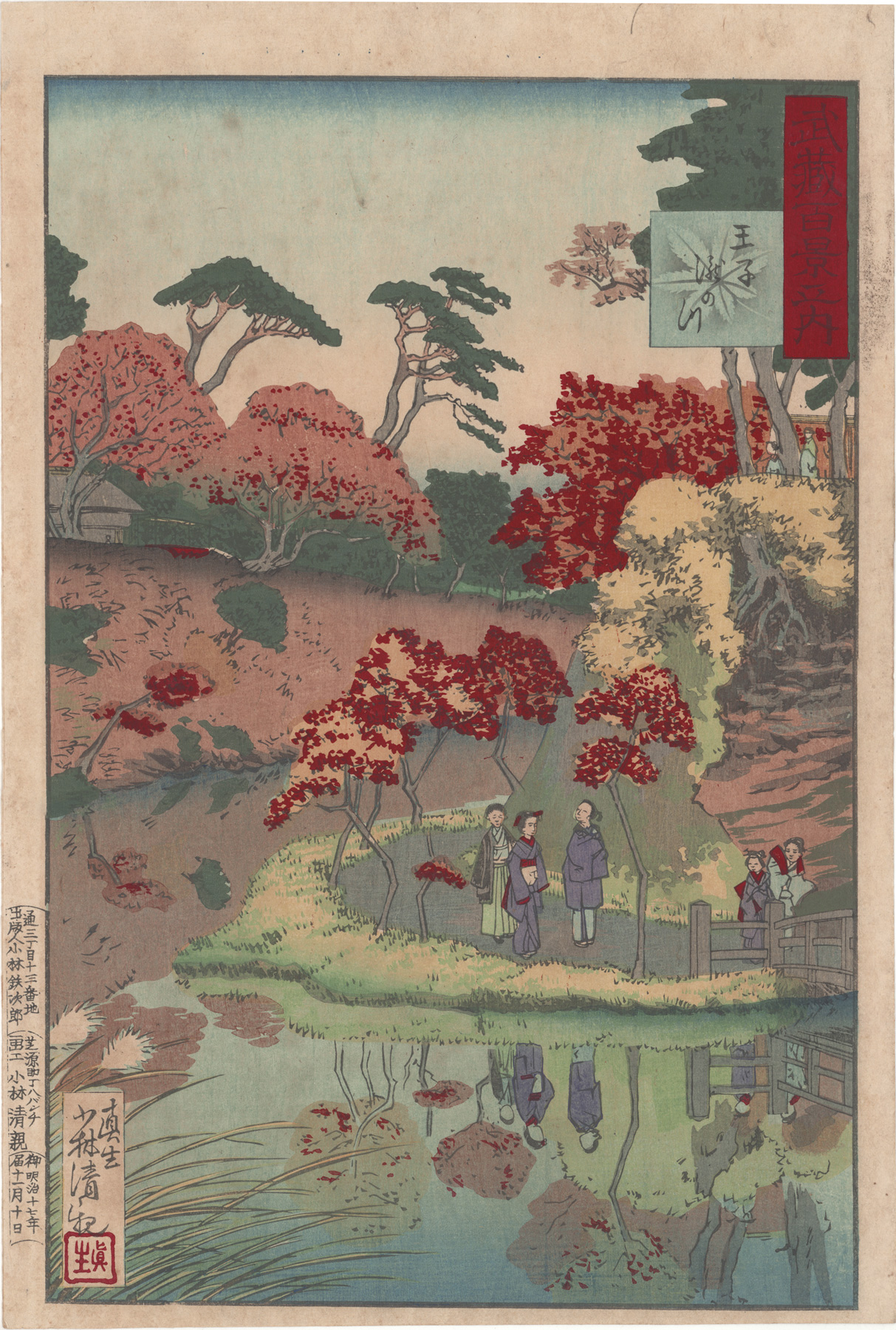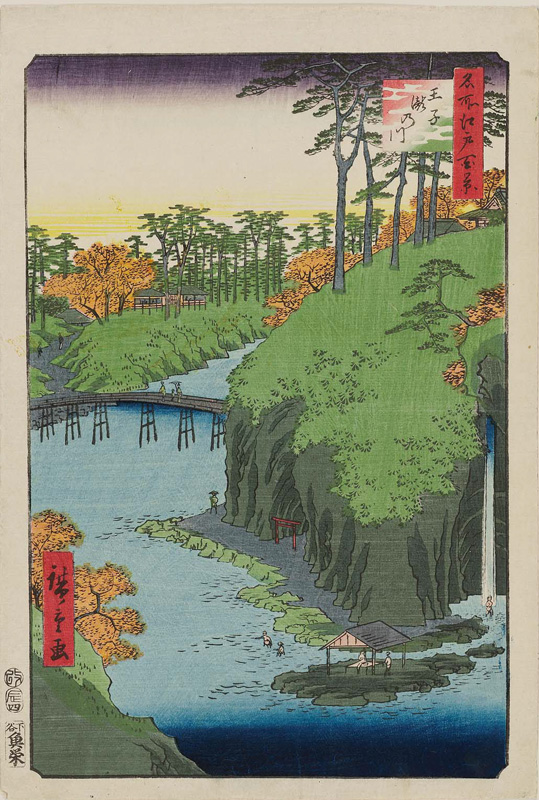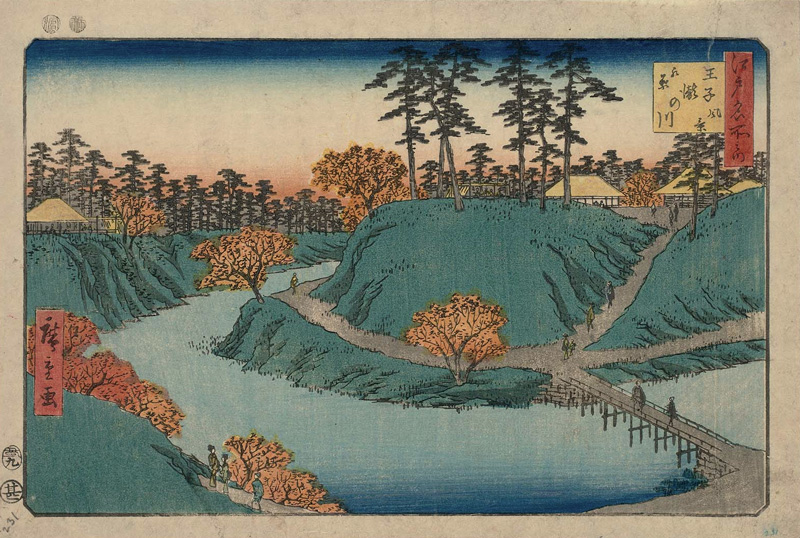About This Print
One of thirty-four prints in the partially completed series One Hundred Views of Musashi. Visitors saunter along the pathway on the banks of the Takinogawa River running through Ōji during the autumn season. Their reflections, along with those of the maple trees, in the Takinogawa are masterfully created and the desigh of this print is quite different from the vertical format Hiroshige print of the same name from his series One Hundred Famous Views of Edo.Musashi is the name of the province in which the city of Edo (later Tokyo) was located. It was once a vast grassy plain and perhaps the long grasses in the lower left of the print are a reference to its once-wild state that would have been largely subsumed as Tokyo expanded.
About The Series One Hundred Views of Musashi
last update:
About The Series One Hundred Views of Musashi
Source: Beyond the Great Wave: The Japanese Landscape Print, 1727-1960, James King, New York: Peter Lang, 2010, p. 125.
"In 1884, Kobayashi Tetsujirō [Tokyo publisher] announced the publication of Kiyochika's One Hundred Views of Musashi. Only thirty-four images were released in this series in which Kiyochika seems to have backtracked away from his earlier experiments with light. These prints partly imitated Hiroshge's One Hundred Famous Views of Edo, but they have a very complicated relationship with their predecessor. The use of the vertical format is similar, as is the use of a close-up view against which is juxtaposed a faraway view. There is, however, a particularly conscious attempt on Kiyochika's part to demonstrate how the city had been subjected to Westernization."
Source: Kiyochika: Artist of Meiji Japan, Henry D. Smith II, Santa Barbara Museum of Art, 1988, p. 69.
In the series One Hundred Views of Musashi, "Kiyochika was not imitating Hiroshige, but rather alluding to Hiroshige’s work in his own mannered and often comic style. Kiyochika was also striving to set his own series apart as the product of a new era, albeit an era in which 'tradition' was looked upon with increasing favor.
In the series One Hundred Views of Musashi, "Kiyochika was not imitating Hiroshige, but rather alluding to Hiroshige’s work in his own mannered and often comic style. Kiyochika was also striving to set his own series apart as the product of a new era, albeit an era in which 'tradition' was looked upon with increasing favor.
Utagawa Hiroshige's Many Views of Ōji Takinogawa
Hiroshige, created at least six different designs of the autumn season along the Takinogawa, three of which are shown below. Kiyochika's print above is most similar in design to Hiroshige's chuban size horizontal formal print shown below (second row right), rather than the vertical format print from the Hiroshige series One Hundred Famous Views of Edo (directly below), which was the inspiration for Kiyochika's series.
37.2 x 25.2 cm (14 2/3 x 9 15/16 in.)
Museum of Fine Arts, Boston 52.1427
Maple Leaves at Waterfall River in Ôji
Ôji Takinogawa kôyô no fûkei), from the series
Famous Places in Edo (Edo meisho no uchi), 1853
25.1 x 37.1 cm (9 7/8 x 14 5/8 in.)
Museum of Fine Arts, Boston 21.10069
Waterfall River at Ôji (Ôji Takinogawa), from the series
Famous Places in Edo (Edo meisho), 1847-1852
16 x 21.7 cm (6 5/16 x 8 9/16 in.)
Museum of Fine Arts, Boston 21.9057
Ōji Takinogawa
Source: Metadata Database of Japanese Old Photographs inBakumatsu-Meiji Period Nagasaki University Library
The red leaves of the Takino River were famous since theEdo era, and many novelists and calligraphers visited the site. The name TakinoRiver originates from the alias of the Shakujii River.
The 8th Shogun, Tokugawa Yoshimune, visited this area in1720-21 and was pleased to find that the Oji Gongen Shrine and the name of theOtonashi River originated in his home province, Kishu. As a result he orderedthe planting of Yoshino cherry trees at Mt. Asuka and maple trees alongTakinogawa to provide autumn colours. Consequently, the Oji area became apopular tourist spot for people from Edo.
View of the maple trees at Takinogawa Oji, from the book
Views of Tokyo in Collotype by K. Ogawa, Photographer, Tokyo,
10 1/8 x 6 3/4 in (25.5 x 17.4 cm), 1895 (Meiji 28),
The photographs of Takinogawa taken during the Meiji Period capture the beauty of the autumn colours. However, after World War II, the development of the residential areas changed the area upstream. The river banks were covered with concrete and the river started to smell due to waste water from houses. The local people launched a movement to protect the river, and finally the government built the Otonashi River Shinsui (Water Friendly) Park in 1985. Spring water is mixed with the natural flow and filtered. Thus, clean water is circulated in certain areas.
Print Details
| IHL Catalog | #1211 |
| Title or Description | Ōji Takinogawa 王子 滝の川 |
| Series | One Hundred Views of Musashi (Musashi hyakkei no uchi 武蔵百景之内) |
| Artist | Kiyochika Kobayashi (1847-1915) |
| Signature |  真生小林清親 |
| Seal | Shinsei (see above) |
| Publication Date |  |
| Publisher |  [Marks: pub. ref. 300; seal ref. similar to 26-139] |
| Carver | other prints in this series carry the carver seal of Hori Fuji, but no carver seal appears on this collection's print. |
| Impression | excellent |
| Colors | good |
| Condition | good - moderate paper toning and soiling; unbacked and full margins |
| Genre | ukiyo-e; meisho-e |
| Miscellaneous | |
| Format | vertical oban |
| H x W Paper | 13 5/8 x 9 1/8 in. (34.6 x 23.2 cm) |
| H x W Image | 12 5/8 x 8 3/8 in. (32.1 x 21.3 cm) |
| Literature | Kiyochika: Artist of Meiji Japan, Henry D. Smith II, Santa Barbara Museum of Art, 1988, cat. 145, p.127. |
| Collections This Print | Santa Barbara Museum of Art Roland A. Way collection1986.31.5 |
4/17/2020






